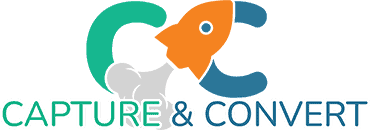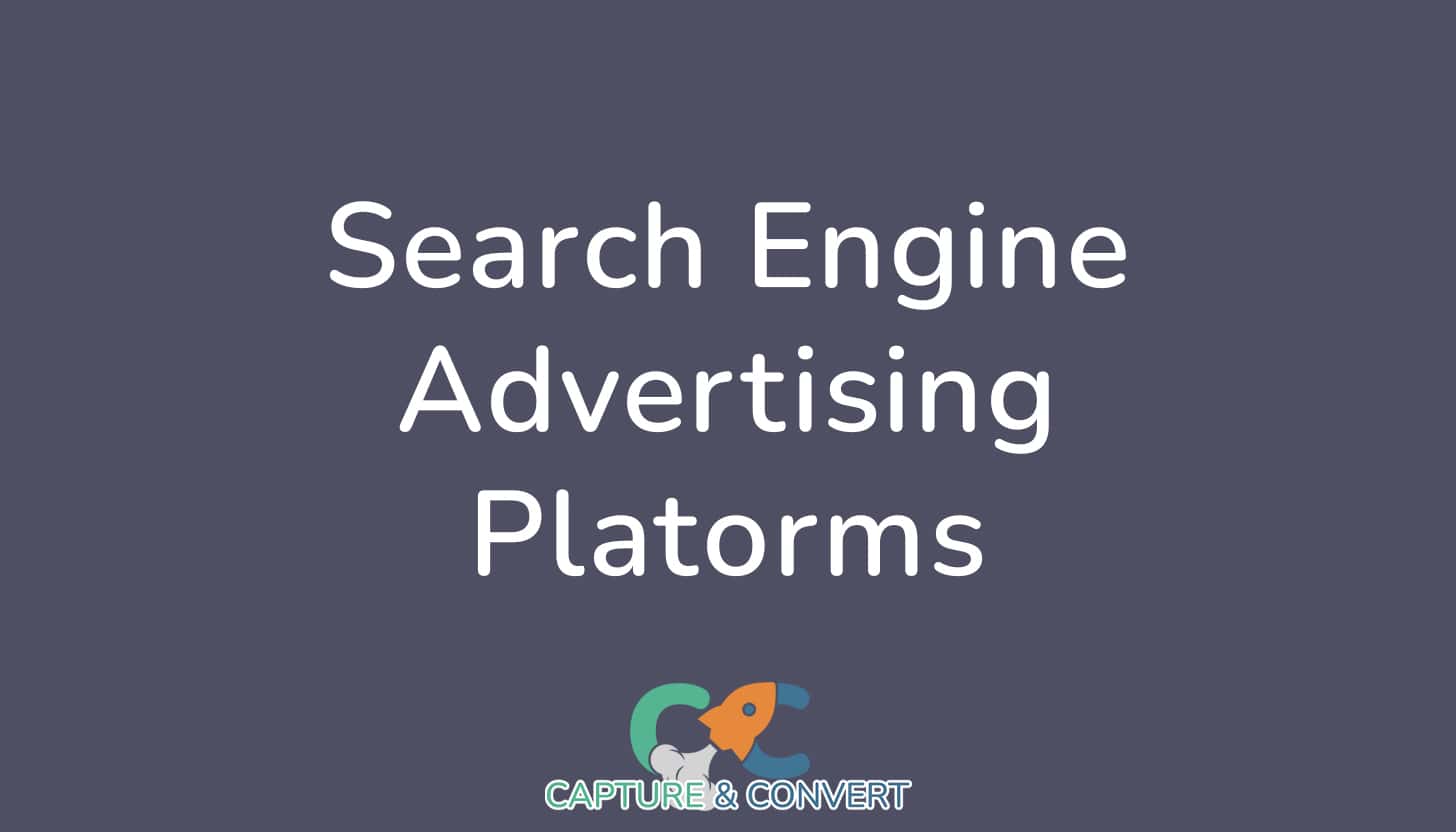Discover the top 7 SEA platforms crucial for generating leads for your local business. Get in-depth reviews, key features, and pricing to help you make an informed choice.
Search Engine Advertising (SEA) is a vital strategy for local businesses striving to increase their local lead generation efforts.
SEA allows businesses to display their ads prominently on search engine result pages, ensuring that potential customers find them when searching for local services or products.
SEA works by allowing businesses to create and bid on text or visual ads, which are displayed on search engine result pages when users enter relevant keywords or phrases.
These ads appear alongside organic search results, giving businesses prime visibility when potential customers search for specific products or services.
Advertisers pay the search engine when users click on their ads, making SEA a pay-per-click (PPC) advertising model that can be highly targeted and result-driven.
In this article, you'll find the top 7 SEA platforms to elevate your local business's visibility and boost lead generation.
Contents
- Importance of SEA Platforms for Local Lead Generation
- SEA's Effectiveness Across Local Business Types
- 1. Google Ads
- 2. Bing Ads
- 3. Yahoo Native (Yahoo Gemini)
- 4. DuckDuckGo Advertising
- 5. Yelp Ads
- 6. Nextdoor Ads
- 7. Amazon Ads
- Variety of Advertising Options in SEA
- Choosing Suitable SEA Platforms
- Legal Aspects of Using SEA
- Learning Curve for SEA Platform Mastery
- Timeliness of Results from SEA Campaigns
- Seasonality's Impact on SEA
- SEA Cost Considerations
- Effects of Pausing or Stopping SEA
- Integrating SEA with Other Lead Generation Tactics
Importance of SEA Platforms for Local Lead Generation

SEA platforms are essential for local lead generation as they allow businesses to display advertisements to users actively seeking products or services in their vicinity.
By appearing in local search results, businesses can connect with potential customers at the right moment, increasing the likelihood of conversions.
This targeted approach ensures that local businesses efficiently utilize their advertising budgets to attract valuable leads, making SEA a cornerstone for successful local lead generation.
Benefits
Listed below are 3 benefits that local businesses can gain from SEA.
- Enhanced Lead Generation: SEA platforms offer precise targeting, allowing local businesses to reach potential customers actively searching for their products or services.
- Increased Brand Visibility: By appearing at the top of search results, businesses boost their brand's visibility and trust among local customers.
- Improved Local Targeting: SEA tools enable businesses to tailor their ads to specific geographical areas, ensuring they connect with local leads more effectively.
Drawbacks

Listed below are 3 possible drawbacks of SEA for local businesses.
- High Costs: Effective use of SEA platforms can be expensive, with costs increasing as competition grows. Businesses must carefully manage their budgets to ensure a positive return on investment (ROI).
- Steep Learning Curve: SEA can be complex for beginners, requiring time and expertise to optimize campaigns effectively. Businesses may consider outsourcing or investing in training to overcome this challenge.
- Platform Dependency: Relying on SEA means being at the mercy of search engine platforms and their algorithm changes. Businesses need to stay adaptable to evolving search engine guidelines to maintain lead generation success.
SEA's Effectiveness Across Local Business Types
SEA can be effective for a wide range of local businesses, particularly those in competitive industries like restaurants, legal services, and healthcare, where appearing at the top of search results is crucial for attracting local customers.
Additionally, businesses with high customer lifetime values, such as auto dealerships and real estate agencies, can benefit significantly from SEA.
However, smaller local businesses with limited budgets may find it challenging to compete effectively in highly competitive markets, and certain industries with low search volume might not see as high returns from SEA.
Listed below are 7 top SEA platforms to skyrocket your local business's lead generation.
- Google Ads
- Bing Ads
- Yahoo Native (Yahoo Gemini)
- DuckDuckGo Advertising
- Yelp Ads
- Nextdoor Ads
- Amazon Ads
1. Google Ads
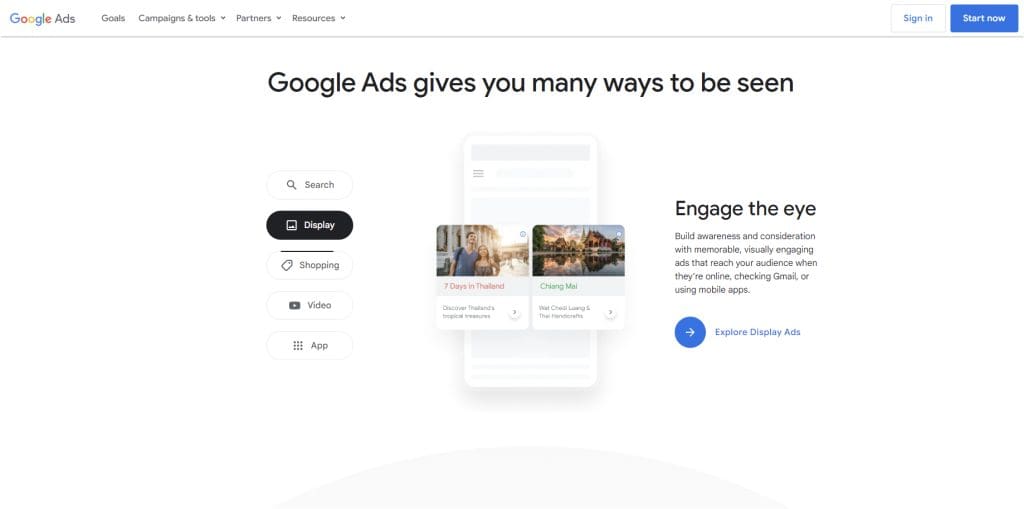
Google Ads is a powerful advertising platform that enables local businesses to create highly targeted ad campaigns to capture local leads effectively.
Key features include keyword targeting, ad scheduling, and the ability to set specific budgets, making it a versatile tool for lead generation.
Google Ads is user-friendly, with a straightforward setup process, and its local extensions allow businesses to display essential information like location and phone number.
The following list shows 3 benefits of using Google Ads.
- Accuracy: Precise local targeting to reach potential customers in specific geographic areas.
- Time Optimization: Ad scheduling for optimizing ad display during peak local traffic times.
- Budget-Friendly: Cost control with customizable budgets to manage expenses effectively.
The following list shows 3 possible drawbacks of Google Ads.
- Pricing: Costs can vary significantly depending on competition and keywords.
- Learning Curve: Steeper learning curve to fully utilize advanced features.
- Ongoing Effort: Requires continuous monitoring to ensure efficient ad spending.
Price
Google Ads operates on a pay-per-click (PPC) model, and costs depend on factors like keyword competitiveness and industry.
Small local businesses may spend around $500 to $2,000 per month.
2. Bing Ads

Bing Ads, part of the Microsoft Advertising platform, provides a valuable alternative to Google Ads.
Its key features include keyword targeting, ad extensions, and detailed reporting, making it suitable for local businesses aiming to generate leads.
The user experience is streamlined, and Bing Ads offers a user-friendly platform for campaign creation and management.
The following list shows 3 main benefits of using Bing Ads for SEA.
- Reach: Reach a different audience, including Windows and Microsoft Edge users.
- Integration: BingAds allows integration with Microsoft Advertising network to expand reach.
- Targeting: Extensive targeting options, including location, device, and demographics.
The following list shows 3 possible drawbacks of using Bing Ads for SEA.
- Limitations: Smaller user base compared to Google Ads.
- Volume: Typically lower traffic volume compared to Google.
- Effort: May require additional effort to maintain campaigns on both Google Ads and Bing Ads.
Price
Costs vary depending on competition and keywords.
Small local businesses may spend around $500 to $2,000 per month.
3. Yahoo Native (Yahoo Gemini)
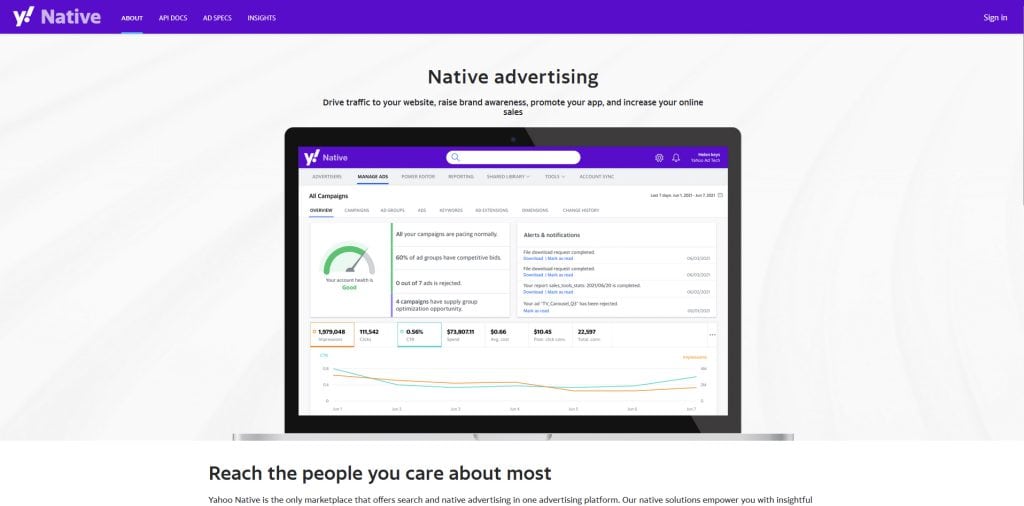
Yahoo Native, powered by Yahoo Gemini, is Yahoo's advertising platform.
It offers features like native ads, search ads, and audience targeting.
For local businesses, it provides a unique opportunity to reach a diverse online audience.
The following list shows 3 benefits of using Yahoo Native.
- Reach: Access to Yahoo's extensive user base.
- Engagement: Native ads seamlessly blend with content for better engagement.
- Accurate Targeting: Targeting options based on user interests, behaviors, and demographics.
The following list shows 3 possible drawbacks of using Yahoo Native.
- User Base: Yahoo Native has a smaller user base compared to Google.
- Limited Reach: When compared to Google Ads, Yahoo Native has a limited reach..
- Integration: Users might encounter integration challenges if not using Yahoo as the primary advertising platform.
Price
Costs depend on factors like competition and audience targeting.
Small local businesses may spend around $500 to $2,000 per month.
4. DuckDuckGo Advertising

DuckDuckGo Advertising is a newer advertising platform that focuses on user privacy and it is served via Microsoft Advertising.
It offers keyword targeting and contextual advertising with a focus on user privacy.
It offers keyword targeting and contextual advertising, making it suitable for local businesses.
The following list shows 3 benefits of using DuckDuckGo Advertising.
- Privacy Sensitive: Adheres to strict privacy policies, appealing to privacy-conscious users.
- Simple: Simplified interface for easy campaign management.
- Effective Targeting: Audience engagement based on contextual targeting.
The following list shows 3 possible drawbacks of using DuckDuckGo Advertising.
- User Base: Smaller user base compared to Google Ads.
- Reach: Limited reach compared to other better established advertising platforms.
- Limited Features: Targeting options may not be as extensive as larger platforms.
Price
Costs may be lower due to lower competition.
Small local businesses may spend around $300 to $1,500 per month.
5. Yelp Ads

Yelp Ads is an advertising platform that specifically caters to local businesses, such as restaurants and services.
Key features include local ad placements, enhanced business profiles, and access to customer reviews and ratings.
The following list shows 3 benefits of using Yelp Ads.
- Targeting: Target users actively seeking local businesses and services.
- Detailed: Enhanced business profiles to showcase products, services, and contact information.
- Customer Engagement: Access to customer reviews and ratings.
The following list shows 3 possible drawbacks of using Yelp Ads.
- Costs: May have high competition and costs in certain industries.
- Business Categories: Limited to specific business categories.
- Reach: Limited reach outside the Yelp platform.
Price
Costs can vary depending on industry and competition.
Small local businesses may spend around $300 to $2,000 per month.
6. Nextdoor Ads
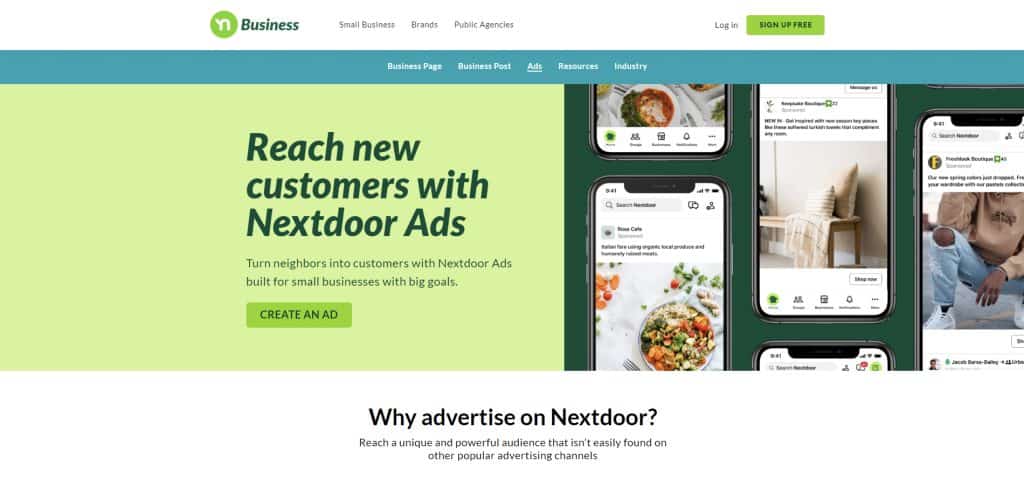
Nextdoor Ads focuses on reaching local neighborhoods and communities.
Key features of Nextdoor Ads include targeting local neighborhoods and communities, offering sponsored posts and hyper-local targeting.
The following list shows 3 major benefits of using Nextdoor Ads.
- Access: Direct access to local neighborhoods and communities.
- Targeting: Sponsored posts to engage users at a neighborhood level.
- Location-Specific: Hyper-local targeting based on specific neighborhoods and interests.
The following list shows 3 possible drawbacks of using Nextdoor Ads.
- Reach: Limited reach compared to larger advertising platforms.
- Scalability: Primarily suitable for businesses serving specific neighborhoods.
- User Base: Smaller user base compared to major advertising platforms.
Price
Costs can be cost-effective for hyper-local targeting.
Small local businesses may spend around $300 to $1,500 per month.
7. Amazon Ads
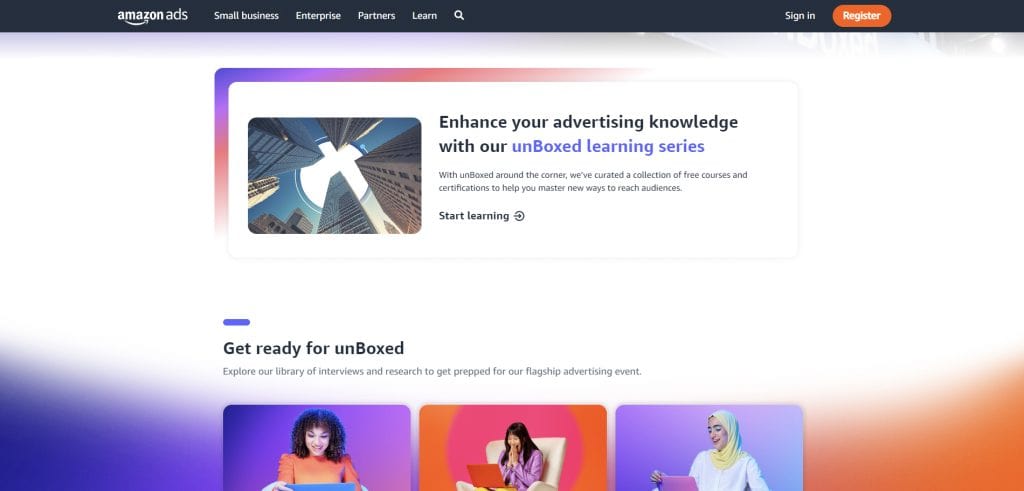
Amazon Ads allows businesses to advertise products on the Amazon platform, featuring product display ads, sponsored products, and detailed reporting for optimization.
The following list shows 3 benefits of using Amazon Ads.
- Intent Focused: Reach users with strong purchase intent on the Amazon platform.
- Visual: Product display ads showcase products to interested customers.
- Analytics: In-depth reporting for optimizing campaigns.
The following list shows 3 possible drawbacks of using Amazon Ads.
- Reach: Limited reach outside the Amazon platform.
- Costs: Competition can be high, leading to increased costs.
- Business Specific: Primarily suitable for e-commerce and product-based businesses.
Price
Costs depend on competition and ad types.
Small local businesses may spend around $500 to $3,000 per month.
Variety of Advertising Options in SEA
Listed below are the 9 different types of advertising options in SEA.
- CPC (Cost Per Click): Advertisers pay for each click on their ads.
- CPM (Cost Per Mille): Charging per thousand ad impressions.
- CPA (Cost Per Acquisition): Calculated based on specific actions taken by users.
- CPV (Cost Per View): Associated with video ads and charged for each view.
- CPE (Cost Per Engagement): Linked to interactions with ad content.
- CPL (Cost Per Lead): Related to generating potential customer contacts.
- ROAS (Return on Ad Spend): Assesses the revenue generated compared to ad expenses.
- Flat Rate Pricing: Advertisers are charged a fixed cost.
- Dynamic Pricing: Adjusts ad costs based on real-time demand and competition in the advertising market.
Choosing Suitable SEA Platforms

Choosing the right SEA platform for your local business involves careful consideration of several key factors.
Begin by assessing the tool's ease of use, ensuring it aligns with your team's skill level and can be seamlessly integrated into your current operations.
Next, evaluate scalability to accommodate your business's growth and increasing SEA needs.
Pay close attention to the platform's geo-targeting capabilities, as precise location targeting is crucial for local businesses.
Finally, factor in budget constraints to find a platform that aligns with your financial resources, providing the best ROI for your lead generation efforts.
Geo-Targeting Capabilities
Geo-targeting capabilities are a core feature of many SEA tools, enabling businesses to focus their advertising efforts on specific local markets.
These tools typically allow users to define geographic parameters such as countries, regions, cities, or even specific radius distances from a physical location.
By setting these parameters, businesses can ensure their ads are shown to users within their target area, increasing the relevance of their campaigns and improving the chances of generating local leads.
Additionally, some platforms offer more advanced geo-targeting options, allowing businesses to fine-tune their campaigns and reach highly localized audiences.
Legal Aspects of Using SEA

Legal considerations are crucial when using SEA to promote local businesses.
These considerations include compliance with advertising standards and regulations set forth by organizations like the Federal Trade Commission (FTC) in the United States or Advertising Standards Authority (ASA) in the United Kingdom.
Businesses must ensure their ads are truthful, not misleading, and comply with industry-specific regulations if applicable (e.g., healthcare or financial services).
Additionally, it's essential to adhere to data protection laws, such as the General Data Protection Regulation (GDPR) in Europe, when collecting user data through forms or tracking pixels.
Violating these legal standards can lead to penalties and damage a business's reputation, underscoring the importance of legal compliance in SEA campaigns.
Learning Curve for SEA Platform Mastery
The learning curve for using SEA platforms can vary depending on the platform's complexity and a user's prior experience.
Some SEA platforms, like Google Ads, offer a user-friendly interface and extensive documentation, making it relatively easy for beginners to start running campaigns.
However, more advanced features, such as bid optimization and in-depth keyword research, may require a steeper learning curve.
It's essential for beginners to take advantage of available resources, tutorials, and customer support to navigate the learning process effectively.
Customization

SEA campaigns offer a high degree of customization, allowing businesses to precisely target their desired demographics, geographic locations, specific times of the day, and even preferred devices.
This level of customization enables businesses to optimize their campaigns to reach the most relevant and potential local customers efficiently.
It's crucial for businesses to take advantage of these customization options to maximize the effectiveness of their SEA campaigns.
Ease of Transition Between Different Platforms
Switching between different SEA platforms can vary in ease, as the process largely depends on the business's current campaign structures, data migration, and familiarity with the new platform.
While it might be relatively straightforward for businesses with basic campaigns, those with complex, long-running campaigns may face challenges in transferring historical data and ensuring campaign continuity.
Additionally, the learning curve of the new platform may impact the transition's overall difficulty.
Timeliness of Results from SEA Campaigns

The time frame for seeing tangible results with SEA can vary based on several factors, including the competitiveness of the keywords, the effectiveness of ad copy, and the relevance of landing pages.
Generally, businesses can expect to see initial results within a few weeks, with more significant results, such as increased lead generation, occurring within a few months of consistent and well-optimized campaigns.
However, it's essential to understand that results can vary, and ongoing campaign optimization is crucial for long-term success.
Evaluating Success
Measuring the success of your SEA campaigns involves tracking various key performance indicators (KPIs) and metrics.
Some critical KPIs include click-through rate (CTR), conversion rate, return on ad spend (ROAS), and cost per acquisition (CPA).
Additionally, using analytics and tracking tools to monitor the quality score, impression share, and ad position can provide insights into campaign performance.
Businesses should focus on these KPIs to assess and optimize their SEA campaigns effectively.
Seasonality's Impact on SEA

Seasonality can significantly affect the effectiveness of SEA campaigns, as search volumes and competition can vary throughout the year.
During peak seasons, costs per click (CPC) tend to rise due to increased demand, making it essential for businesses to adjust their budgets accordingly.
Leveraging seasonal-specific keywords and ad copy, creating promotional offers, and closely monitoring campaign performance are effective strategies to mitigate the effects of seasonality and maximize ROI.
SEA Cost Considerations
The cost of SEA for local businesses can vary significantly based on several factors.
It typically includes variable costs like CPC (Cost Per Click) or CPM (Cost Per Thousand Impressions), and additional costs can include setup fees and ongoing monthly or annual subscriptions.
SEA platforms often offer tiered pricing plans, with higher-cost plans providing more advanced features, which may be suitable for businesses with larger budgets.
Smaller local businesses might find success with more conservative budgets, while larger enterprises might allocate substantial funds for robust SEA campaigns.
Professional SEA Management
Hiring a professional for managing SEA campaigns can be advisable for businesses that lack the expertise or time to navigate the complexities of search engine advertising effectively.
Professional agencies or consultants can offer in-depth knowledge, optimize campaigns, and maximize ROI.
Businesses with substantial budgets or specific needs might find the investment in professional management to be worthwhile for achieving their lead generation goals.
Effects of Pausing or Stopping SEA

Pausing or stopping SEA campaigns can result in an immediate drop in website traffic and lead generation, as your ads will no longer appear in search results.
In the long term, discontinuing campaigns may affect your ad quality and the historical data that search engines use to determine ad relevance.
It's crucial to carefully plan and execute pauses to minimize negative impacts and consider seasonal factors, budget adjustments, and strategies for resuming campaigns when needed.
Integrating SEA with Other Lead Generation Tactics
SEA platforms can be seamlessly integrated with other lead generation strategies to create a comprehensive marketing approach.
By combining SEA with SEO efforts, businesses can optimize their online presence to attract organic traffic.
Additionally, integrating SEA with social media marketing allows for cohesive brand messaging and reaching audiences through multiple channels, improving lead generation efforts.
This synergy among different strategies enhances a business's overall online visibility and engagement with potential leads.
SEA and SEO: Complementary Strategies
SEA and SEO can work together as complementary strategies for local lead generation.
While local SEO strategies focus on optimizing a website to improve organic search rankings, SEA operates by placing paid advertisements at the top of search results.
When used together, businesses can maximize their online visibility, capturing leads through both organic and paid search methods.
However, it's important to balance the two strategies effectively to avoid high costs and ensure long-term success in local lead generation.
